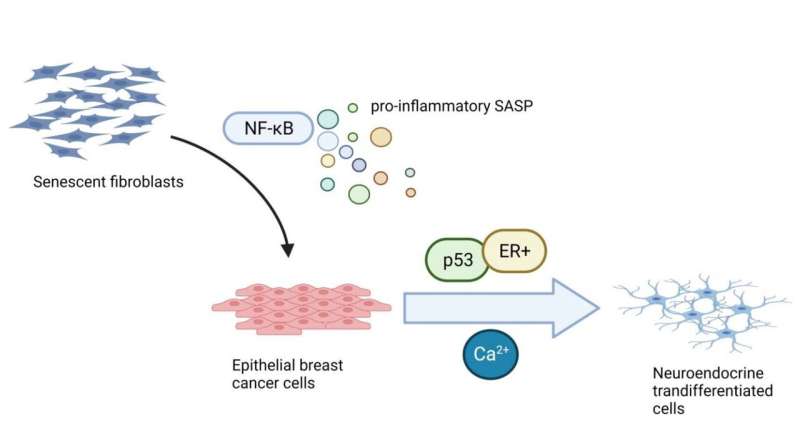This article has been reviewed according to Science X's editorial process and policies. Editors have highlighted the following attributes while ensuring the content's credibility:
fact-checked
proofread
The senescence-associated secretory phenotype induces neuroendocrine transdifferentiation

A new editorial paper, titled "The senescence-associated secretory phenotype induces neuroendocrine transdifferentiation," was recently published in the journal Aging
In this editorial, researchers Anda Huna, Nadine Martin and David Bernard from the Université de Lyon discuss the senescence-associated secretory phenotype (SASP). SASP, in addition to stable proliferation arrest, is one of the most remarkable characteristics of senescent cells. Indeed, these cells secrete a variety of factors including cytokines, growth factors and matrix metalloproteases among others. In response to stress, through their SASP, senescent cells are able to modify and instruct their microenvironment.
"The SASP is known to have several, sometimes contradictory, effects on phenotypes, including the induction or reinforcement of senescence in neighboring cells, promotion or inhibition of stemness, modification of extracellular matrix, activation or inhibition of immune responses and induction of epithelial-mesenchymal transition and cell migration," note the researchers.
Although cellular senescence and its SASP can initially display some beneficial effects, for instance favoring wound healing or blocking tumor initiation, accumulation of senescent cells and their secretome during aging or chronic stresses (tobacco, obesity, alcohol among others) plays a significant role in promoting aging-associated features and pathologies, like fibrosis, steatosis, chronic inflammation or cancer.
In the context of cancer, senescence initially has an antitumoral role, as it promotes proliferation arrest and favors an anti-tumoral immune surveillance in response to oncogenic stress or DNA damage accumulation. However, SASP plays a dual role in tumor initiation and progression, as it first has a tumor suppressive action by reinforcing senescence in neighboring cells and recruiting immune cells, but also plays a tumor promoting role by promoting stemness, epithelial-mesenchymal transition and cell migration and by inhibiting immune responses.
"Overall our work reveals a new effect of senescent cells and their SASP in tumors and offers new insights into NED [neuroendocrine transdifferentiation] in breast and prostate cancer biology. It also provides a new vision of the contribution of senescent cells and their SASP to aging-related pathologies, which could involve NED induction in some contexts," the researchers conclude.
More information: Anda Huna et al, The senescence-associated secretory phenotype induces neuroendocrine transdifferentiation, Aging (2023). DOI: 10.18632/aging.204669




















